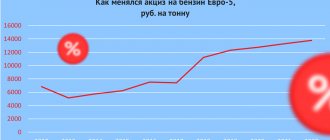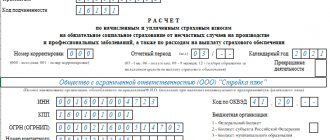Hello! In this article we will talk about excise taxes on alcohol.
Today you will learn:
- What is excise duty called and what types is it divided into?
- Who pays excise taxes on alcohol;
- What is the procedure for calculating and paying excise tax?
The rates for 2022 for a number of positions are brought into compliance with Law No. 301-FZ of 08/03/2018. For alcoholic products it remained at the 2022 level. We’ll talk about this, as well as the terms and procedures for payment today.
Content
- Excise tax on alcohol: the essence of the concept and why it is needed
- What is subject to excise tax
- Who pays excise taxes
- How is it different from VAT?
- Types of excise tax rates
- Excise tax rates on alcohol
- Level of increase in alcohol prices
- Calculation and payment of excise taxes
- Timing and procedure
- Goods exempt from excise duty
- The situation with other excisable products
- Labeling of alcoholic beverages
- Consequences of non-payment
- Conclusion
Excise tax on alcohol: the essence of the concept and why it is needed
Excise tax is a duty established by the state for producers of alcoholic beverages, tobacco products and a number of other goods. But today we will dwell in more detail only on the tax for alcohol producers. This tax is called internal, operating within the borders of the state.
In addition, excise taxes in Russia are included in the price of goods, which means that the consumer pays for them. If excisable products are sold at retail, the amount of excise tax is not allocated.
So why are excise taxes needed? The answer is simple: so that the state receives profit from the manufacture of products that are popular among the population. And also, according to experts, increasing excise taxes is an effective measure in the fight against excessive alcohol consumption.
Negative sides:
- Increase in volumes of illegally imported alcohol;
- The risk of increasing sales of obviously low-quality alcoholic beverages.
How will this affect producers?
To understand how much the excise burden on producers is increasing, let’s calculate the amount of excise tax paid by some abstract enterprise before and after the rate increase.
There are two formulas for calculating excise taxes.
A = K x C, where
A – excise tax,
K – quantity of excisable products produced during the tax period,
C – excise tax rate.
This formula is used for goods with a fixed excise tax rate. But there is another one:
A = (O x TC) + (OS x AC), in which:
A – excise tax;
О – total quantity of excisable products sold;
TS – fixed rate;
OS – the total amount of revenue for excisable products;
AC – ad valorem rate.
However, this rate is used not for alcoholic products, but for cigarettes, cigars and other things, so in our calculations we will limit ourselves to the first formula.
Let’s say the Dobry Melnik brewery annually produces 2,000 liters of beer with a strength of up to 8.6% and 3,000 liters of beer with a strength of 8.6% or more.
In 2022, the amount of excise tax will be equal to:
2000 x 21 + 3000 x 39 = 42,000 + 117,000 = 159,000 rub.
In 2022, the amount of excise tax will be equal to:
2000 x 22 + 3000 x 41 = 44,000 + 123,000 = 167,000 rub.
In 2022, the amount of excise tax will be equal to:
2000 x 23 + 3000 x 43 = 46,000 + 129,000 = 175,000 rub.
Thus, provided that production volumes remain constant, the amount of excise taxes paid by the brewery will increase by 8 thousand rubles. Of course, the main burden here falls on the buyer - excise tax is one of the indirect taxes included in the price of the product and paid by the consumer of the product. Manufacturers may also suffer if, due to forced price increases, their sales volumes decrease. Consumers can switch to cheaper analogues or completely refuse to consume such products.
Thus, excise taxes are a policy instrument through which the state encourages citizens to refuse to consume harmful goods. We examined in theory and calculated in practice how the upcoming increase in excise taxes will turn out, and also figured out why alcohol addiction of citizens is unprofitable for the state. By the way, the story is about the same with excise taxes on tobacco products, and excise taxes on gasoline and cars are a kind of environmental protection measure.
How is it different from VAT?
VAT, like excise tax, is an indirect tax. But there are fundamental differences between them, which we will discuss in more detail.
- VAT is charged on a much larger volume of goods. It also applies to services provided by the payer. In turn, excise taxes are established only on goods;
- The next difference is that excise tax is a real burden on the entrepreneur, and when paying VAT, if you use deductions wisely, the burden can be significantly reduced;
- It is not always possible to compensate for the excise tax rate using a deduction;
- Excise taxes, unlike VAT, have a serious impact on the profitability of the company.
Excise taxes in Russia began to operate in 1991. The main elements from which the excise tax is formed are the base, object and tax rate.
Types of excise tax rates
- Specific;
- Combined;
- Ad valorem.
Specific
Presented in a fixed amount for 1 unit of goods. Most often used.
Ad valorem
It is uniform for the entire country and is set as a percentage of excisable goods. Its weakness is that each time you need to calculate the customs value of the product.
Combined
Combines specific and ad valorem rates.
Requirements for the new alcohol labeling procedure
So, we are talking about alcoholic products subject to FSM labeling. What are these brands?
The federal special stamp is a document certifying the legality of the production and circulation of alcoholic beverages on the territory of the Russian Federation. It is also a carrier of EGAIS information. It contains a two-dimensional bar code applied by the brand manufacturer and containing the EGAIS identifier in encoded form.
The government has set a fixed price for FSM - 1,890 rubles per 1,000 pieces, excluding VAT. The recipient pays for the stamps in advance at his own expense.
Who should receive the new stamps:
- organizations producing alcohol in the Russian Federation;
- organizations purchasing alcohol for import into the Russian Federation.
If alcohol products are subject to mandatory labeling, what sequence of actions must be performed to obtain the FSM? Can they refuse to issue stamps?
Below are the turnover periods for federal special stamps, how long they can be stored and whether they can simply be thrown away if they have not been used:
Excise tax rates on alcohol
Next, we will consider the amount of excise taxes on alcoholic products, presenting the information in table form. And then we’ll do a little comparative analysis.
Excise taxes on alcohol in 2022:
| Product type | Tax rate 2021 | Tax rate 2021 | Tax rate 2022 (from 01.01.) |
| Ethyl. alcohol, which is sold by companies involved in the production of cosmetics. or perfume. products | 1 liter / 0 rub. | 1 liter / 0 rub. | 1 liter / 0 rub. |
| Ethyl. alcohol sold by companies that do not pay advance excise taxes | 1 liter – 107 rub. | 1 liter – 107 rub. | 1 liter – 107 rub. |
| Alcohol containing more than 9% alcohol (excluding beer and sparkling wine) | 1 liter – 523 rub. | 1 liter – 523 rub. | 1 liter – 523 rub. |
| Alcohol containing less than 9% alcohol (excluding beer and sparkling wine) | 1 liter – 418 rub. | 1 liter – 418 rub. | 1 liter – 418 rub. |
| Wine, excluding sparkling wine | 1 liter – 5 rub. | 1 liter – 5 rub. | 1 liter – 5 rub. |
| Sparkling wine | 1 liter – 36 rub. | 1 liter – 36 rub. | 1 liter – 27 rub. |
| Beer with up to 0.5% alcohol | 1 liter – 0 rub. | 1 liter – 0 rub. | 1 liter – 0 rub. |
| Beer containing from 0.5% to 8.6% alcohol | 1 liter – 21 rub. | 1 liter – 21 rub. | 1 liter – 21 rub. |
| Beer with more than 8.6% | 1 liter – 39 rub. | 1 liter – 39 rub. | 1 liter – 39 rub. |
The excise tax on alcohol brings the highest income to the state when compared with other taxes. And tax rates on vodka are much higher than on other alcohol. This is an argument in favor of reducing the production of such a drink.
Ethyl alcohol is the main source of profit from the use of excise duties. The excise duty on alcohol brings the highest income to the state when compared with other taxes. And tax rates on vodka are much higher than on other alcohol. This is an argument in favor of reducing the production of such a drink.
Comparing rates over several years, we see that in 2022 they remained almost at the 2022 level.
Let’s see below how this affected alcohol prices in various retail chains.
New excisable goods
From January 1, 2022, the list of excisable goods has become larger. This is a new version of Art. 181 of the Tax Code of the Russian Federation, introduced sub. “g”, “d”, “f” and “g” art. 1 of the Law of September 29, 2019 No. 326-FZ.
As a result, from 01/01/2020 the following became excisable goods:
- any electronic cigarettes (until 2022 - only disposable ones) and devices for heating tobacco, used to create tobacco vapor inhaled by the consumer by heating tobacco without burning or smoldering (excise tax - 50 rubles per piece);
- grapes, which are used for the production of wines, champagne, liqueurs, wine materials, grape must and other alcoholic beverages produced using full cycle technology (excise tax - 30 rubles per 1 ton);
- beer with strength up to 0.5 degrees inclusive;
- wine materials (intended for the production of distillates), grape and fruit must.
Level of increase in alcohol prices
Excise taxes on alcohol are planned to increase only in 2021. on the:
- Products containing ethyl alcohol over 9% up to 544 rubles, the excise tax is now 523 rubles.
- Products containing ethyl alcohol less than 9% up to 435 rubles, against 418 rubles, the current rate for 2022.
- Wine – the excise tax rate will be 19 rubles. per liter, now it is 18 rubles.
- Ethyl alcohol sold by companies that do not pay advance excise tax payments up to 111 rubles. per liter Now the excise tax rate is 107 rubles. per liter
Raising rates
There will also be an increase in excise taxes on some excisable goods from 2022. The main reason is inflation. In particular, excise tax rates have been increased on:
- ethyl alcohol sold by organizations that did not transfer the advance payment and did not provide a bank guarantee;
- wines, regardless of protected geographical indication or place of origin;
- beer with strength from 0.5 to 8.6 degrees;
- all types of tobacco products;
- cars with engine power over 90 hp. With.;
- diesel fuel.
This is a new version of Art. 193 of the Tax Code of the Russian Federation, introduced clause 6 of Art. 1 of the Law of September 29, 2019 No. 326-FZ.
KEEP IN MIND
From 2022, rates for wines, including fruit and champagnes, will not be differentiated depending on whether a geographical indication or appellation of origin is protected.
So, initially for 2022 the excise tax was 19 rubles. per liter of “unprotected” wine and 5 rubles. per liter of “protected”. But taking into account changes in the Tax Code of the Russian Federation, a single rate for wine has been established - 31 rubles. per liter
The same story with champagne: for 2022 it was 37 rubles. per liter of “unprotected” and 14 rubles. per liter of “protected”. As a result, the flat rate is 40 rubles. per liter
The table below shows all changes in excise tax rates.
| Types of excisable goods | Rate (in % and/or rubles per unit) |
| from January 1 to December 31, 2020 incl. | |
| Ethyl alcohol produced from food or non-food raw materials, including denatured ethyl alcohol, raw alcohol, distillates: | |
| sold to organizations paying an advance payment of excise tax, including imported into the Russian Federation from the territories of member states of the Eurasian Economic Union, which is a product of the Eurasian Economic Union; | 0 rubles per 1 liter of anhydrous ethyl alcohol contained in excisable goods |
| sold to organizations that have certificates provided for in paragraph 1 of Article 179.2 of this Code; | 0 rubles per 1 liter of anhydrous ethyl alcohol contained in excisable goods |
| transferred when performing transactions recognized as an object of excise taxation in accordance with subparagraph 22 of paragraph 1 of Article 182 of this Code; | 0 rubles per 1 liter of anhydrous ethyl alcohol contained in excisable goods |
| sold to organizations that have not fulfilled the obligation to pay an advance payment of excise tax (have not provided a bank guarantee and a notice of exemption from payment of an advance payment of excise tax) and (or) do not have the certificates provided for in paragraph 1 of Article 179.2 of this Code; | 544 rubles per 1 liter of anhydrous ethyl alcohol contained in excisable goods |
| imported into the Russian Federation, not being a product of the Eurasian Economic Union, and also being a product of the Eurasian Economic Union, imported into the Russian Federation from the territories of the member states of the Eurasian Economic Union, provided there is no obligation to pay an advance payment of excise tax (except for the submission of a bank guarantee and notice on exemption from payment of advance payment of excise tax) or failure to fulfill the obligation to pay advance payment of excise tax; | 544 rubles per 1 liter of anhydrous ethyl alcohol contained in excisable goods |
| transferred within the structure of one organization when the taxpayer carries out operations recognized as the object of taxation by excise taxes, with the exception of operations provided for by subparagraph 22 of paragraph 1 of Article 182 of this Code; | 544 rubles per 1 liter of anhydrous ethyl alcohol contained in excisable goods |
| received (posted) by organizations that have certificates provided for in paragraph 1 of Article 179.2 of this Code | 544 rubles per 1 liter of anhydrous ethyl alcohol contained in excisable goods |
| Alcohol-containing products | 544 rubles per 1 liter of anhydrous ethyl alcohol contained in excisable goods |
| Grapes used for the production of wine, sparkling wine (champagne), liqueur wine with a protected geographical indication, with a protected designation of origin (special wine), wine materials, grape must, alcoholic beverages produced using full-cycle technology, sold in the tax period | 30 rubles per 1 ton |
| Wine materials, grape must, fruit must | 31 rubles per 1 liter |
| Alcohol products with a volume fraction of ethyl alcohol over 9 percent (except for beer, wines, fruit wines, sparkling wines (champagne), wine drinks made without the addition of rectified ethyl alcohol produced from food raw materials, and (or) alcoholized grape or other fruit wort and (or) distillates) | 544 rubles per 1 liter of anhydrous ethyl alcohol contained in excisable goods |
| Alcohol products with a volume fraction of ethyl alcohol up to 9 percent inclusive (except for beer, drinks made from beer, wines, fruit wines, sparkling wines (champagnes), cider, poiret, mead, wine drinks made without the addition of rectified ethyl alcohol, produced from food raw materials, and (or) alcoholized grape or other fruit must, and (or) distillates) | 435 rubles per 1 liter of anhydrous ethyl alcohol contained in excisable goods |
| Wines, fruit wines (except for sparkling wines (champagne), liqueur wines) | 31 rubles per 1 liter |
| Wine drinks made without the addition of rectified ethyl alcohol produced from food raw materials, and (or) alcoholized grape or other fruit must, and (or) distillates | 40 rubles per 1 liter |
| Cider, poire, mead | 22 rubles per 1 liter |
| Sparkling wines (champagnes) | 40 rubles per 1 liter |
| Beer with a standard (standardized) content of ethyl alcohol by volume up to 0.5 percent inclusive | 0 rubles per 1 liter |
| Beer with a standard (standardized) content of ethyl alcohol by volume over 0.5 percent and up to 8.6 percent inclusive, drinks made from beer | 22 rubles per 1 liter |
| Beer with a normative (standardized) content of ethyl alcohol by volume over 8.6 percent | 41 rubles per 1 liter |
| Pipe, smoking, chewing, sucking, snorting, hookah tobacco (except for tobacco used as raw material for the production of tobacco products) | 3172 rubles per 1 kg |
| Cigars | 215 rubles for 1 piece |
| Cigarillos (cigaritas), bidis, kretek | 3055 rubles for 1000 pieces |
| Cigarettes, cigarettes | 1,966 rubles per 1,000 pieces + 14.5 percent of the estimated cost, calculated based on the maximum retail price, but not less than 2,671 rubles per 1,000 pieces |
| Tobacco (tobacco products) intended for consumption by heating | 6040 rubles per 1 kg |
| Electronic nicotine delivery systems, tobacco heating devices | 50 rubles for 1 piece |
| Liquids for electronic nicotine delivery systems | 13 rubles per 1 ml |
| Passenger cars: | |
| with engine power up to 67.5 kW (90 hp) inclusive | 0 rubles for 0.75 kW (1 hp) |
| with engine power over 67.5 kW (90 hp) and up to 112.5 kW (150 hp) inclusive | 49 rubles for 0.75 kW (1 hp) |
| with engine power over 112.5 kW (150 hp) and up to 150 kW (200 hp) inclusive | 472 rubles for 0.75 kW (1 hp) |
| with engine power over 150 kW (200 hp) and up to 225 kW (300 hp) inclusive | 773 rubles for 0.75 kW (1 hp) |
| with engine power over 225 kW (300 hp) and up to 300 kW (400 hp) inclusive | 1317 rubles for 0.75 kW (1 hp) |
| with engine power over 300 kW (400 hp) and up to 375 kW (500 hp) inclusive | 1363 rubles for 0.75 kW (1 hp) |
| with engine power over 375 kW (500 hp) | 1408 rubles for 0.75 kW (1 hp) |
| Motorcycles with engine power over 112.5 kW (150 hp) | 472 rubles for 0.75 kW (1 hp) |
| Automotive gasoline: | |
| not corresponding to class 5 | 13,100 rubles per 1 ton |
| class 5 | 12,752 rubles per 1 ton |
| Diesel fuel | 8835 rubles per 1 ton |
| Motor oils for diesel and/or carburetor (injection) engines | 5616 rubles per 1 ton |
| Aviation kerosene | 2800 rubles per 1 ton |
REFERENCE
Excise duty on wines and fruit wines:
- in 2022 – 31 rubles. for 1 liter;
- in 2022 – 32 rubles;
- in 2022 – 33 rubles.
Excise tax on sparkling wines (champagne):
- in 2022 – 40 rubles. for 1 liter;
- in 2022 – 41 rubles;
- in 2022 – 43 rubles.
Calculation and payment of excise taxes
In this part of our conversation, we will give an example of how excise tax is calculated, for example, at a fixed rate.
For this, the following calculation formula is used:
A = Nb * Tc, where A is the accrued amount of excise duty, Nb is the tax base (the number of goods sold), Tc is the fixed rate.
So, Company S. produced and sold 700 liters of beer, which is strong. This means that she will have to pay: 700 * 21 = 14,700 rubles.
The combined rate is calculated using the following formula:
A = Nb * Tc + O + Ac /100%, where A is the amount of excise duty, Nb is the tax base, Tc is a fixed rate, O is the amount that will be received upon the sale of Nb, Ac is the percentage rate.
Tax base for tobacco products
When selling cigarettes and cigarettes, the tax base consists of two parts and is defined as:
- the volume of goods sold (transferred) in kind – for the application of a fixed tax rate;
- the estimated value of these goods is for the application of the ad valorem tax rate.
This procedure is provided for in paragraph 2 of Article 187 and Article 193 of the Tax Code of the Russian Federation.
To determine the estimated cost of cigarettes or cigarettes, use the following formula:
| Estimated cost of goods sold (transferred) | = | Maximum retail price indicated on a pack of cigarettes or cigarettes | × | Number of cigarettes or cigarettes sold or transferred during the tax period (in packs) |







